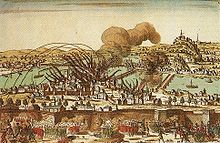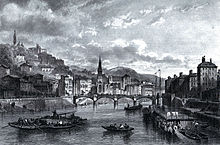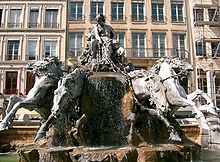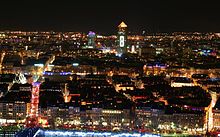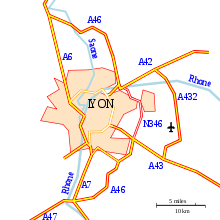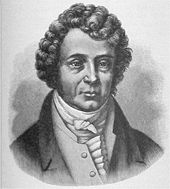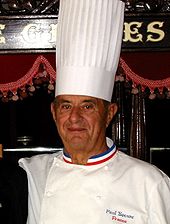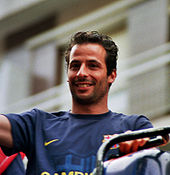- Lyon
-
This article is about the French city. For other uses, see Lyon (disambiguation).
Lyon
Motto: Avant, avant, Lion le melhor.
(Franco-Provençal: Forward, forward, Lyon the best)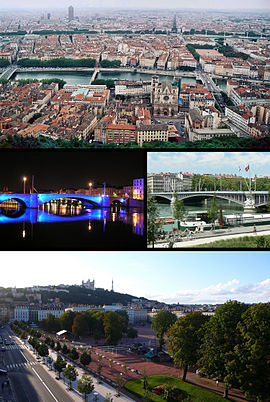
Top, Lyon, with the old city in the foreground. Center, the Pont Bonaparte, the night, et the Pont Lafayette. Down, the Place Bellecour, with, in the background, the Basilica of Our Lady and the Tour Metal. 

City flag City coat of arms Administration Country France Region Rhône-Alpes Department Rhône Arrondissement Lyon Canton chief town of 14 cantons Subdivisions 9 arrondissements Intercommunality Urban Community
of LyonMayor Gérard Collomb (PS)
(2008–2014)Statistics Elevation 162–305 m (531–1,001 ft) Land area1 47.95 km2 (18.51 sq mi) Population2 483,181 (2008) - Ranking 3rd in France - Density 10,077 /km2 (26,100 /sq mi) Urban area 954.19 km2 (368.41 sq mi) (1999) - Population 1,422,331 (2007) Metro area 3,306 km2 (1,276 sq mi) (2006) - Population 2,118,132 (2008) Time zone CET (GMT +1) INSEE/Postal code 69123/ 69001-69009 Website lyon.fr 1 French Land Register data, which excludes lakes, ponds, glaciers > 1 km² (0.386 sq mi or 247 acres) and river estuaries. 2 Population without double counting: residents of multiple communes (e.g., students and military personnel) only counted once. Coordinates: 45°45′35″N 4°50′32″E / 45.759723°N 4.842223°E
Lyon (French pronunciation: [ljɔ̃] (
 listen) localy [lijɔ̃]; Arpitan: Liyon, IPA: [ʎjɔ̃]; English: /liːˈɒn/ or anglicized as Lyons[nb 1]/ˈlaɪ.ənz/), is a city in east-central France in the Rhône-Alpes region, situated between Paris and Marseille. Lyon is located at 470 km (292 mi) from Paris, 320 km (199 mi) from Marseille, 160 km (99 mi) from Geneva, 280 km (174 mi) from Turin, and 600 km (373 mi) from Barcelona. The residents of the city are called Lyonnais.
listen) localy [lijɔ̃]; Arpitan: Liyon, IPA: [ʎjɔ̃]; English: /liːˈɒn/ or anglicized as Lyons[nb 1]/ˈlaɪ.ənz/), is a city in east-central France in the Rhône-Alpes region, situated between Paris and Marseille. Lyon is located at 470 km (292 mi) from Paris, 320 km (199 mi) from Marseille, 160 km (99 mi) from Geneva, 280 km (174 mi) from Turin, and 600 km (373 mi) from Barcelona. The residents of the city are called Lyonnais.The city of Lyon has 480,660 inhabitants.[1] Together with its suburbs and satellite towns, Lyon forms the second-largest metropolitan area in France after Paris, with the population of its urban area estimated to be 1,422,331 and that of its metropolitan area 1,757,180.[2][3] Its urban region represents half of the Rhône-Alpes region population with 2.9 million inhabitants.[4] Lyon is the capital of this region, as well as the capital of the smaller Rhône département.
The city is known for its historical and architectural landmarks and is a UNESCO World Heritage Site. Lyon was historically known as an important area for the production and weaving of silk and in modern times has developed a reputation as the capital of gastronomy in France. It has a significant role in the history of cinema due to Auguste and Louis Lumière. The local professional football team, Olympique Lyonnais, has increased the profile of Lyon internationally through participation in European football championships.
Economically, Lyon is a major centre for banking and also the chemical, pharmaceutical, and biotech industries. The city contains a significant software industry with a particular focus on video games, and in recent years has focussed on a growing local start-up sector.[5] Lyon also hosts the international headquarters of Interpol, Euronews and International Agency for Research on Cancer. Lyon is ranked 2nd in France as an economic centre and convention centre on some measures.[6] Lyon was in 2010 ranked 9th globally and 2nd in France for innovation.[7] It ranked 38th globally in Mercer's 2010 liveability rankings.
Contents
History
- Main article for early history: Lugdunum. Main article for later history: History of Lyon.
-
Further information: Ecclesiastical history of Lyon
 Lucius Munatius Plancus, founder of Lyon
Lucius Munatius Plancus, founder of Lyon
Lyon was founded on the Fourvière hill as a Roman colony in 43 BC by Munatius Plancus, a lieutenant of Caesar, on the site of a Gaulish hill-fort settlement called Lug[o]dunon, from the Celtic god Lugus ('Light', cognate with Old Irish Lugh, Modern Irish Lú) and dúnon (hill-fort). Lug[us] was equated by the Romans to Mercury.
Marcus Vipsanius Agrippa recognized that Lugdunum's position on the natural highway from northern to south-eastern France made it a natural communications hub, and he made Lyon the starting point of the principal Roman roads throughout Gaul. It then became the capital of Gaul, partly thanks to its convenient location at the convergence of two navigable rivers, and quickly became the main city of Gaul. Two emperors were born in this city: Claudius and Caracalla. Today, the archbishop of Lyon is still referred to as "Primat des Gaules" and the city often referred to as the "capitale des Gaules".
The Christians in Lyon were martyred for their religion under the reigns of the various Roman emperors, most notably Marcus Aurelius and Septimus Severus. Local saints from this period include saints such as Blandina (Blandine), Pothinus (Pothin), and Epipodius (Épipode), among others.
The great Christian bishop of Lyon in the 2nd century was the Easterner Irenaeus.
Burgundian refugees from the destruction of Worms by the Huns in 437 were resettled by the military commander of the west, Aëtius, at Lugdunum, which was formally the capital of the new Burgundian kingdom by 461.
In 843, by the Treaty of Verdun, Lyon, with the country beyond the Saône, went to Lothair I, and later became a part of the Kingdom of Arles. Lyon only came under French control in the 14th century.
Fernand Braudel remarked, Historians of Lyon are not sufficiently aware of the bi-polarity between Paris and Lyon, which is a constant structure in French development from the late Middle Ages to the Industrial Revolution (Braudel 1984 p. 327). The fairs in Lyon, the invention of Italian merchants, made it the economic countinghouse of France in the late 15th century. When international banking moved to Genoa, then Amsterdam, Lyon simply became the banking centre of France; its new Bourse (treasury), built in 1749, still resembled a public bazaar where accounts were settled in the open air. During the Renaissance, the city developed with the silk trade, especially with Italy; the Italian influence on Lyon's architecture can still be seen.[8]
Lyon was a scene of mass violence against Huguenots in the St. Bartholomew's Day Massacres in 1572.
During the French Revolution, Lyon rose up against the National Convention and supported the Girondins. In 1793, the city was under siege for over two months, assaulted by the Revolutionary armies, before eventually surrendering. Several buildings were destroyed, especially around the Place Bellecour, and Jean-Marie Collot d'Herbois with Joseph Fouché administered the execution of more than 2,000 people. A decade later, Napoleon himself ordered the reconstruction of all the buildings demolished during this period.
Thanks to the silk trade, the city became an important industrial town during the 19th century but in 1831 and 1834, the silk workers of Lyon, known as canuts, staged two major uprisings. The 1831 uprising saw one of the first recorded uses of the black flag as an emblem of protest. The world's first funicular railway was built between Lyon and La Croix-Rousse in 1862.
Lyon was a centre for the occupying German forces and also a stronghold of resistance during World War II, and the city is now home to a resistance museum. (See also Klaus Barbie.) The traboules, or secret passages, through the houses enabled the local people to escape Gestapo raids.
Geography
Lyon's geography is dominated by the Rhône and Saône rivers that converge to the south of the historic city centre forming a peninsula or "Presqu'île"; two large hills, one to the west and one to the north of the historic city centre; and a large plain which sprawls eastward from the historic city centre. The original medieval city (Vieux Lyon) was built on the west bank of the Saône river at the foot of the Fourvière hill, west of the Presqu'île. This area, along with portions of the Presqu'île and much of the Croix-Rousse is recognized as a UNESCO World Heritage Site.
To the west is Fourvière, known as "the hill that prays", the location for the highly decorated basilica of Notre-Dame de Fourvière, several convents, the palace of the Archbishop, the Tour métallique (a highly visible TV tower, replicating the last stage of the Eiffel Tower) and a funicular (a railway on a steep hill).
To the north is the Croix-Rousse, "the hill that works", traditionally home to many small silk workshops, an industry for which the city was once renowned.
Place Bellecour is located on the Presqu'île between the two rivers and is the third largest public square in France. The broad, pedestrian-only Rue de la République leads north from Place Bellecour. The 2nd arrondissement has many of the finest old residential buildings in Lyon and the area is known for its concentration of old Lyonnaise Catholic families, particularly in the Ainay part of the arrondissement.
East of the Rhône from the Presqu'île is a large area of flat ground upon which sits much of modern Lyon and most of the city's population. Situated in this area is the urban centre of Part-Dieu which clusters the Tour Part-Dieu (affectionately nicknamed "The Pencil"), the Tour Oxygène, the Tour Swiss Life, a shopping centre, and one of Lyon's two major rail terminals, Lyon Part-Dieu.
North of this district is the relatively wealthy 6th arrondissement, which is home to the Parc de la Tête d'Or, one of Europe's largest urban parks, the prestigious Lycée du Parc to the south of the park, and Interpol's world headquarters on the park's western edge. The park contains a free zoo that has recently been upgraded.
Climate
Lyon is classed as borderline Oceanic and Humid Subtropical (Koppen Cfb/Cfa). Winters are cooler than much of the rest of France due to its more inland position, but generally not cold, averaging 3.2 °C (37.8 °F) in January. Summers are very warm, averaging 21.3 °C (70.3 °F) in July. Precipitation is adequate year-round, at an average of 840 millimetres (33.1 in), but the winter months are the driest.
Climate data for Lyon Month Jan Feb Mar Apr May Jun Jul Aug Sep Oct Nov Dec Year Record high °C (°F) 17.9
(64.2)21.9
(71.4)25.7
(78.3)30.1
(86.2)34.2
(93.6)38.4
(101.1)39.8
(103.6)40.5
(104.9)35.8
(96.4)28.4
(83.1)23.0
(73.4)20.2
(68.4)40.5
(104.9)Average high °C (°F) 6.2
(43.2)8.4
(47.1)12.4
(54.3)15.3
(59.5)20.0
(68.0)23.5
(74.3)27.0
(80.6)26.7
(80.1)22.3
(72.1)16.7
(62.1)10.2
(50.4)7.1
(44.8)16.3 Average low °C (°F) 0.1
(32.2)1.2
(34.2)3.3
(37.9)5.6
(42.1)9.9
(49.8)13.1
(55.6)15.6
(60.1)15.3
(59.5)11.9
(53.4)8.4
(47.1)3.6
(38.5)1.5
(34.7)7.5 Record low °C (°F) −23
(−9)−22.5
(−8.5)−10.5
(13.1)−4.4
(24.1)−3.8
(25.2)2.3
(36.1)6.1
(43.0)4.6
(40.3)0.2
(32.4)−4.5
(23.9)−9.4
(15.1)−24.6
(−12.3)−24.6
(−12.3)Precipitation mm (inches) 52.9
(2.083)50.5
(1.988)54.8
(2.157)72.3
(2.846)87.7
(3.453)80.2
(3.157)62.0
(2.441)69.0
(2.717)88.3
(3.476)94.7
(3.728)75.1
(2.957)55.5
(2.185)843.1
(33.193)Avg. precipitation days 9 9 9 10 11 9 7 7 8 10 9 10 108 Sunshine hours 69 97 172 180 225 232 275 259 187 111 70 55 1,932 Source: Météo France[9] Administration
Main article: Arrondissements of Lyon Map of the City of Lyon divided into 9 arrondissements
Map of the City of Lyon divided into 9 arrondissements
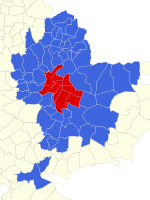 Map of the Urban Community of Greater Lyon (the city of Lyon is in red)
Map of the Urban Community of Greater Lyon (the city of Lyon is in red)
Lyon is the capital of the Rhône-Alpes région, the préfecture of the Rhône département, and the capital of 14 cantons, covering 1 commune, and with a total population of 480,660.[1]
Like Paris and Marseille, the city of Lyon is divided into a number of municipal arrondissements, each of which is identified by a number and has its own council and town hall. Five arrondissements were originally created in 1852, when three neighbouring communes (La Croix-Rousse, La Guillotière, and Vaise) were annexed by Lyon. Between 1867 and 1959, the 3rd arrondissement (which originally covered the whole of the Left Bank of the Rhône) was split three times, creating a new arrondissement in each case. Then, in 1963, the commune of Saint-Rambert-l'Île-Barbe was annexed to Lyon's 5th arrondissement. A year later, in 1964, the 5th was split to create Lyon's 9th – and, to date, final – arrondissement. Within each arrondissement, there are a number of recognisable quartiers or neighbourhoods:
- 1st arrondissement : Slopes of La Croix-Rousse, Terreaux, Martinière/St-Vincent
- 2nd arrondissement : Cordeliers, Bellecour, Ainay, Perrache, Confluent
- 3rd arrondissement : Guillotière (north), Préfecture, Part-Dieu, Villette, Dauphiné/Sans Souci, Montchat, Grange Blanche (north), Monplaisir (north)
- 4th arrondissement : Plateau de la Croix-Rousse, Serin
- 5th arrondissement : Vieux Lyon (Saint-Paul, Saint-Jean, Saint-Georges), Saint-Just, Saint-Irénée, Fourvière, Point du Jour, Ménival, Battières, Champvert (south)
- 6th arrondissement : Brotteaux, Bellecombe, Parc de la Tête d'Or, Cité Internationale
- 7th arrondissement : Guillotière (south), Jean Macé, Gerland
- 8th arrondissement : Monplaisir (south), Bachut, États-Unis, Grand Trou/Moulin à Vent, Grange Blanche (south), Laënnec, Mermoz, Monplaisir-la-Plaine
- 9th arrondissement : Vaise, Duchère, Rochecardon, St-Rambert-l'Île-Barbe, Gorge de Loup, Observance, Champvert (north)
Geographically, Lyon's two main rivers, the Saône and the Rhône, divide the arrondissements into three groups:
- To the west of the Saône, the 5th arrondissement covers the old city (Vieux Lyon), Fourvière hill and the plateau beyond. The 9th is immediately to the north, and stretches from Gorge de Loup, through Vaise to the neighbouring suburbs of Écully, Champagne-au-Mont-d'Or, Saint-Didier-au-Mont-d'Or, Saint-Cyr-au-Mont-d'Or and Collonges-au-Mont-d'Or.
- Between the two rivers, on the Presqu'île are the 2nd, 1st and 4th arrondissements. The 2nd includes most of the city centre, including Bellecour and Perrache railway station, and reaches as far as the confluence of the two rivers. The 1st is directly to the north of the 2nd and covers part of the city centre (including the Hôtel de Ville) and the slopes of La Croix-Rousse. To the north of the Boulevard is the 4th arrondissement, which covers the Plateau of La Croix-Rousse, up to its boundary with the commune of Caluire-et-Cuire.
- To the east of the Rhône, are the 3rd, 6th, 7th and 8th arrondissements.
The Urban Community of Lyon, also known as Greater Lyon is the intercommunal structure gathering the city and some of its suburbs. The Urban Community encompasses only the core of the metropolitan area of Lyon.
Culture
Historic Site of Lyons * UNESCO World Heritage Site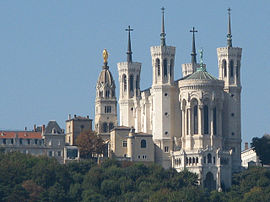
Basilica of Notre-Dame de Fourvière on the hill.Country France Type Cultural Criteria ii, iv Reference 872 Region ** Europe and North America Inscription history Inscription 1998 (22nd Session) * Name as inscribed on World Heritage List
** Region as classified by UNESCO- Since the Middle Ages, the residents of the region, speak several dialects of Arpitan language. The Lyonnais dialect was partly replaced by the French language as the importance of the city grew. However, it is still alive and, in addition, some "frenchified" Franco-Provençal words can also be heard in the French of the Lyonnais, who call their little boys and girls "gones" and "fenottes" for example.[10]
- Lyon was an early centre for printing books, and nurtured a circle of 16th century poets.[citation needed]
- The Lumière brothers pioneered cinema in the town in 1895. The Musée Lumière, built as Auguste Lumiere's house, and a fascinating piece of architecture in its own right, holds many of their first inventions and other early cinematic and photographic artefacts.
- 8 December each year is marked by the Festival of Lights (la Fête des lumières), a celebration of thanks to the Virgin Mary, who purportedly saved the city from a deadly plague in the Middle Ages. During the event, the local population places candles (lumignons) at their windows and the city of Lyon organizes impressive large-scale light shows onto the sides of important Lyonnais monuments, such as the medieval Cathédrale St-Jean.
- The church of Saint Francis of Sales is famous for its large and unaltered Cavaillé-Coll pipe organ, attracting audiences from around the world.
- The Opéra Nouvel (Nouvel Opera House) is the home of the Opéra National de Lyon. The original opera house was re-designed by the distinguished French architect, Jean Nouvel between 1985 and 1993 and is named after him.
- Lyon is also the French capital of "trompe l'œil" walls, a very ancient tradition. Many are to be seen around the city. This old tradition is now finding a contemporary expression, for example in the art of Guillaume Bottazzi.[11][12]
- The Brothers of the Sacred Heart, a Roman Catholic congregation that operates schools in Europe and North America, was founded in Lyon in 1821.
- The African Museum of Lyon is one of the oldest museums situated in Lyon.[13]
- The Museum of Resistance and Deportation looks at the various persons prominent in the Resistance movement in World War II. The building is strongly linked to Klaus Barbie. Lyon sees itself as the centre of the French resistance and many members were shot in Place Bellecour in the town centre. The exhibition is largely a series of mini-biographies of those involved.
- The unusual project Lyon Dubai City, a reproduction of some districts of Lyon in Dubai, is a major point for the tourism in Lyon.
- Lyon is a pilot city of the Council of Europe and the European Commission Intercultural cities programme.
UNESCO World Heritage Site
The Historic Site of Lyon was designated a UNESCO World Heritage Site in 1998. In their designation, UNESCO cited the "exceptional testimony to the continuity of urban settlement over more than two millennia on a site of great commercial and strategic significance."[14] The specific regions composing the Historic Site include the Roman district and Fourvière, the Renaissance district (Vieux Lyon), the silk district (slopes of Croix-Rousse), and the Presqu'île, which features architecture from the 12th century to modern times.[15] Both Vieux Lyon and the slopes of Croix-Rousse are known for their narrow passageways (named traboules) that pass through buildings and link streets on either side. The first examples of traboules are thought to have been built in Lyon in the 4th century. The traboules allowed the inhabitants to get from their homes to the Saône river quickly and allowed the canuts on the Croix-Rousse hill to get quickly from their workshops to the textile merchants at the foot of the hill.
Gastronomy
For several centuries Lyon has been known as the French capital of gastronomy, due in part to the presence of many of France's finest chefs in the city and its surroundings (e.g. Paul Bocuse). This reputation also comes from the fact that two of France's best known wine-growing regions are located near Lyon: the Beaujolais to the North, and the Côtes du Rhône to the South. Beaujolais wine is very popular in Lyon and remains the most common table wine served with local dishes.
Lyon is the home of very typical and traditional restaurants serving local dishes, and local wines: the bouchons.
The city is famous for its morning snacks formerly had by its silk workers, the mâchons, made up of local charcuterie and usually accompanied by Beaujolais red wine. Traditional local dishes include Rosette lyonnaise and saucisson de Lyon (sausage), andouillette (a sausage of coarsely cut tripe), pistachio sausage, coq au vin, esox (pike) quenelle, gras double (tripe cooked with onions), salade lyonnaise (lettuce with bacon, croutons and a poached egg), marrons glacés, coussin de Lyon and cardoon au gratin.
Cervelle de canut (lit. silk worker's brains) is a cheese spread/dip, a Lyonnais speciality. The dish is a base of fromage blanc, seasoned with chopped herbs, shallots, salt, pepper, olive oil and vinegar.
Economy
 Interpol's world headquarters in Lyon
Interpol's world headquarters in Lyon
The GDP of Lyon is 62 billion euro,[16] and the city is the second richest city after Paris. Lyon and its region Rhône-Alpes represent one of the most important economies in Europe and, according to the Loughborough university, can be compared to Philadelphia, Mumbai or Athens concerning its international position. The city of Lyon is working in partnerships to more easily enable the establishment of new headquarters in the territory (ADERLY, Chambre du commerce et d'industrie, Grand Lyon...). According to the ECER-Banque Populaire, Lyon is the 14th favorite city in the European Union concerning the creation of companies and investments. High-tech industries like biotechnology, software development, game design, and internet services are also growing. Other important sectors include medical research and technology, non-profit institutions, and universities. Lyon is home to some of the most dangerous viruses in the world (class 4) in the Jean Merieux laboratory of research, like Ebola, Marburg, Nipah, Hendra, and Lassa.[17]
The city is the headquarters of many companies like Euronews, Lyon Airports, BioMérieux, Sanofi Pasteur, LCL S.A., Cegid Group, Boiron, Infogrames, Groupe SEB, LVL Medical, GL Events, Compagnie Nationale du Rhône, and intergovernmental agencies IARC, Interpol. The specialization of some sectors of activities have the consequence of creating several main business centers: La Part-Dieu, located in the 3rd arrondissement is the second biggest business quarter after La Défense in Paris with over 1,600,000 m2 (17,222,256.67 sq ft) of office space and services and more than 40,000 jobs.[18] Cité Internationale, created by the architect Renzo Piano is located in the border of the Parc de la Tête d'Or in the 6th arrondissement. The worldwide headquarters of Interpol is located there. The district of Confluence, in the south of the historic centre, is a new pole of economical and cultural development.
Tourism provides a big boost to the Lyon economy with one billion euros in 2007 and 3.5 million hotel nights in 2006 provided by non-residents. Approximately 60% of tourists visit for business with the rest for leisure. In January 2009 Lyon ranked first in France for hostels business. The festivals most important for attracting tourists are the Fête des lumières, the Nuits de Fourvière every summer, the Biennale d'art contemporain and the Nuits Sonores.
Demographics

Main sights
Antiquity
- The Roman ruins on the hillside near the Fourviere Basilica with the Ancient Theatre of Fourvière, the Odeon of Lyon and the accompanying Gallo-Roman Museum.
- Amphitheatre of the Three Gauls, roman ruins of an amphiteatre.
Middle Ages and Renaissance
- Cathedral of St. John, a medieval church with architectural elements of the 13th, 14th and 15th centuries. It is the principal religious structure in the city and the seat of the Archbishop of Lyon.
- Basilica of St-Martin-d'Ainay is one of the rare surviving Romanesque basilica-style churches in Lyon.
- Église Saint-Paul, Romanesque (12 and 13th century) and Gothic (15–16th century) church.
- Église Saint-Bonaventure, 14th- and 15th-century Gothic church.
- Eglise Saint-Nizier, Gothic church from the 15th century. Its doorway was carved in the 16th century by Philibert Delorme.
- Vieux Lyon (English: Old Lyon) area – Medieval and Renaissance quarter of the town, with cobbled streets, shops, and dining.
- The many Renaissance hôtels particuliers of the Old Lyon quarter, such as the Hôtel de Bullioud, also built by Philibert Delorme.
17th and 18th century
- City Hall on the Place des Terreaux, built by architects Jules Hardouin-Mansart and Robert de Cotte.
- Musée des beaux-arts de Lyon, fine arts museum housed in a former convent of the 17th century, including the Baroque chapelle Saint-Pierre.
- Hôtel-Dieu de Lyon (17th and 18th century), historical hospital with a baroque chapel.
- Temple du Change (17th and 18th century), former stock exchange of Lyon, Protestant temple since the 18th century.
- Place Bellecour, one of the largest town squares in Europe.
- Chapelle de la Trinité (1622), the first Baroque chapel built in Lyon, it was part of the former École de la Trinité, now Collège-lycée Ampère.
- Église Saint-Polycarpe (1665–1670), Classical church.
- Église Saint-Just (16th to 18th century), Classical church.
- Saint-Bruno des Chartreux (17th and 18th century), church, masterpiece of Baroque architecture.
- Église Notre Dame Saint-Vincent (18th century), Neoclassical church.
19th century and modern city
- Opéra National de Lyon (1831), renovated in 1993 by Jean Nouvel.
- Basilica of Notre-Dame de Fourvière, large 19th century basilica on the top of Fourvière Hill.
- Tour métallique de Fourvière (1894).
- La Mouche Cattle Market and Abbatoir (1914, 1928), designed by Tony Garnier.
- Sainte Marie de La Tourette monastery (1960) designed by Le Corbusier
- Saint-Exupéry International Airport (formerly Satolas Airport), designed by Guillaume Gilbert.
- Gare de Lyon Saint-Exupéry (1994) by Santiago Calatrava.
- Palais des congrès de Lyon (1998), designed by Renzo Piano is a group of buildings for various functions.
- Tour du Crédit Lyonnais
- Tour Oxygène
- Tour Incity
Museums
- Musée des beaux-arts de Lyon (Fine Arts Museum), main museum of the city and one of the largest art galleries in France. Housed in the "Palais Saint Pierre", a former 17th century convent, it displays a major collection of paintings (Tintoretto, Paolo Veronese, Nicolas Poussin, Rubens, Rembrandt, Zurbaran, Canaletto, Delacroix, Monet, Gauguin, Van Gogh, Cézanne, Matisse, Picasso, Francis Bacon...), collections of sculptures, drawings and printings, decorative arts, roman and Greek antiquities, the second largest collection of Egyptian antiquities in France after that of the Louvre and a medal cabinet of 50 000 medals and coins.
- The Gallo-Roman Museum displays many valuable objects and artworks found on the site of Roman Lyon (Lugdunum) such as Circus Games Mosaic, Coligny calendar and the Taurobolic Altar.
- African Museum of Lyon
- Centre d'histoire de la résistance et de la déportation
- Musée des Confluences, planned future museum of Sciences and anthropology.
- La Sucrière, contemporary art center.
- Musée des Tissus et des Arts Décoratifs, decorative arts museum.
- Musée d'art contemporain de Lyon, contemporary art museum.
- Musée Gadagne, museum of the history of Lyon housed in a historic building in Vieux Lyon.
Parks and gardens
 The lake, in the Parc de la Tête d'Or.
The lake, in the Parc de la Tête d'Or.
- Parc de la Tête d'Or, (literally, Golden Head Park), in central Lyon is the largest urban park in France at 117 hectares. Located in the 6th arrondissement, it features a large lake on which boating takes place during the summer months. Due to the relatively small number of other parks in Lyon, it receives a huge number of visitors over summer, and is a frequent destination for joggers and cyclists. At the northern end of the park, there is a small zoo, with giraffes, elephants, tigers and other animals. There is also sporting equipment, such as a velodrome, boules court, mini-golf, horse riding, and even a miniature train.
- Jardin botanique de Lyon (8 hectares), included in the Parc de la Tête d'Or, is a municipal botanical garden. It is open weekdays without charge. The garden was established in 1857 as a successor to earlier botanical gardens dating to 1796, and now describes itself as France's largest municipal botanical garden. Today it contains about 15,000 plants, including 3500 plants of temperate regions, 760 species of shrubs, a hundred species of wild roses, 750 varieties of historical roses, 200 varieties of peonies recognized by the Conservatoire Français des Collections Végétales Spécialisées, 1800 species of alpine plants, 50 varieties of water lilies, and 6,000 species in its greenhouses. The garden's greenhouses enclose a total of 6,500 m2 (69,965.42 sq ft) in area, and include a central pavilion for tropical plants including camellias over a hundred years old; a greenhouse-aquarium with Amazonian water lilies; a Dutch greenhouse containing carnivorous plants; small greenhouses with orchids; and small cold greenhouses with azaleas, cactus, and so forth.
- Parc de Gerland, in the south of the city (80 hectares).
- Parc des hauteurs, in Fourvières.
- Parc de Miribel-Jonage (300 hectares).
- Parc de Lacroix-Laval (115 hectares).
- Parc de Parilly (178 hectares).
Education
- ECE Lyon (École de Commerce Européenne de Lyon)
- Institut d'études politiques de Lyon
- CPE Lyon
- École Centrale de Lyon
- ECAM Lyon (École Catholique d'Arts et Métiers de Lyon)
- EM Lyon (École de Management de Lyon)
- ENTPE (École Nationale des Travaux Publiques de l'État)
- École des Beaux-Arts
- École Normale Supérieure de Lyon
- Institut National des Sciences Appliquées de Lyon (located in Villeurbanne)
- ISTIL (Institut des Sciences et Techniques de l'Ingénieur de Lyon) (located in Villeurbanne)
- ISARA (Institut Supérieur d'Agriculture Rhône Alpes)
- Institution des Chartreux
- Université Claude Bernard (Lyon 1)
- Université Lumière (Lyon 2)
- Université Jean Moulin (Lyon 3)
- IAE (Institut d'Administration des Entreprises de Lyon)
- Catholic University of Lyon
- ESDES Business School
- IDRAC (International School of Management)
- Wesford Graduate Business School
- IFAG (Business Management School)
- Le Lycée du Parc
- La Martiniere Lyon
- CEESO (Centre Européen d'Enseignement Supérieur de l'Ostéopathie)
- Bellecour, Ecoles D'Arts
There are some international private schools in Lyon, including:
- Cité Scolaire Internationale de Lyon
- Ombrosa
- International School of Lyon
- Montessori School of Lyon
Sport
Lyon is home to the Ligue 1 football team Olympique Lyonnais, commonly known as "Lyon" or "OL". The team has enjoyed unprecedented success recently, winning seven consecutive national titles and establishing themselves as France's premier football club. The team competes in the prestigious UEFA Champions League and currently plays at the Stade de Gerland, where the Danone Nations Cup is held every year. The team is set to move to a new stadium in Décines-Charpieu (in the eastern suburbs) in 2013, which will hold 61,556 people. Lyon also has a rugby union team, Lyon OU, currently playing in Top 14. In addition, Lyon has a rugby league side: Lyon Villeurbanne Rhône XIII, or LVR XIII,[19] play in the French rugby league championship. The club's current home ground is Stade Georges Lyvet in Villeurbanne. Lyon is also home to the Lyon Hockey Club, an ice hockey team that competes in France's national ice hockey league. Finally, Villeurbanne also has a renowned basketball team, ASVEL, who play at the Astroballe arena in Laurent Bonnevay.
Transport
Saint-Exupéry International Airport, located east of Lyon, serves as a base for domestic and international flights. It is an important transport facility for the entire Rhône-Alpes region. Coach links connect the airport with the centre of Lyon and other towns in the area including Chambéry and Grenoble. With its in-house train station (Gare de Lyon Saint-Exupéry) the airport is also connected to the TGV network. The new Rhônexpress tram links the international airport with the business quarter of La Part Dieu in less than 30 minutes. The Lyon-Bron Airport is a smaller airport dedicated to General Aviation (both private and commercial). Having helipads, the facility hosts a Gendarmerie and a Sécurité Civile (civilian defence) Base.
Lyon has two major railway stations: Lyon Part-Dieu, which was built to accommodate the TGV and has become the principal railway station for extra-regional trains; and Lyon Perrache, which is an older station that now primarily serves regional rail services. In practice, many trains, including TGVs, serve both stations. Smaller railway stations include Gorge-de-Loup, Vaise, Vénissieux, Saint-Paul and Jean Macé. Lyon is connected to the north (Lille, Paris, Brussels, and in the future Amsterdam) and the south (Marseille, Montpellier, and in the future Barcelona, Turin) by the TGV. It was the first city to be connected to Paris by the TGV in 1981.
The city is at the heart of a dense road network and is located at the meeting point of several highways: A6 (to Paris), A7 (to Marseille), A42 (to Geneve), A43 (to Grenoble). The city is now bypassed by the A46. A double motorway tunnel passes under Fourvière, connecting the A6 and the A7 autoroutes, both forming the "Autoroute du Soleil". Prior to the construction of the bypass by the east, the tunnel was famous for its traffic jams, since traffic between northern and southern France, as well as from neighboring countries and local traffic all wanted to cross, Lyon being virtually the only low passage between the Alps and the Massif Central (extinct) volcano range. Lyon is served by the Eurolines intercity coach organisation. Its Lyon terminal is located at the city's Perrache railway station, which serves as an intermodal transportation hub that also includes tramways, local and regional trains and buses, the terminus of metro line A, the bicycle service Vélo'v, and taxis.
The TCL (for Transports en Commun Lyonnais), Lyon's public transit system, consisting of metro, buses and tramways, serves 62 communes of the Lyon agglomeration. The metro network has 4 lines ( A B C D), 39 stations and runs with a frequency of up to a train every 2 minutes. The bus network consists of normal buses, trolleybuses and coaches for areas outside the centre. There are 4 tram lines ( T1 T2 T3 T4) since April 2009: T1 from Montrochet in the south to IUT-Feyssine in the north, Tram T2 from Perrache railway station in the southwest to Saint-Priest in the southeast, Tram T3 from Part-Dieu to Meyzieu, and Tram T4 from Mendès-France to Feyzin. There are also two funicular lines from Vieux Lyon to Saint-Just and Fourvière. Despite the existence of several systems and operators the ticketing is unified through a unique system. The Réseau Express de l'Aire urbaine Lyonnaise (REAL) project intends on promoting and eventually increasing, the usage of public transport means by commuters. The public transit system is complemented by Vélo'v, a bicycle network providing a low cost and convenient bicycle hire service where bicycles can be hired and dropped off at any of 340 stations throughout the city. Borrowing a bicycle for less than 30 minutes is free.
Notable residents
- Éric Abidal, footballer
- Frederique Bangue, athlete
- Claudius (10 BC – AD 54), Roman emperor
- Caracalla (188–217), Roman emperor
- Irenaeus (2nd century AD – 202), Bishop
- André-Marie Ampère (1775–1836), physicist and mathematician
- Raymond Barre, French politician
- Azouz Begag
- Karim Benzema,footballer
- Paul Bocuse (born 1926), chef
- Gérard Collomb
- Clovis Cornillac
- Natalie Dessay
- Youri Djorkaeff, footballer
- Liane Foly
- Éric Guirado
- Maurice Jarre
- Jean Michel Jarre (son of Maurice Jarre, above)
- Allan Kardec
- Katsuni
- Jérôme Kerviel
- Alexandre Lacassagne
- Edmond Locard
- Auguste and Louis Lumière
- André Manoukian
- Jean-Baptiste Maunier
- Jean Moulin
- Bruno N'Gotty, footballer
- Emile Ntamack, rugby player
- Abbé Pierre
- Antoine de Saint-Exupéry
- Jean-Baptiste Say
- Louis Gabriel Suchet
- Bertrand Tavernier
- Seyhan Kurt,poet,writer
- Sylvie Testud
- Florence Foresti, humorist
Movies in Lyon
- 1895: 14 vues Lumière filmées à Lyon entre 1895 et 1900 by Auguste and Louis Lumière
- 1929: The kiss, Le baiser by Jacques Feyder with Greta Garbo
- 1938: Le petit chose by Maurice Cloche with Arletty, Robert Lynen
- 1945: 120 rue de la Gare by Jacques Daniel-Norman with René Dary, Sophie Desmarets
- 1946: Un revenant by Christian-Jaque with Louis Jouvet, Gaby Morlay, François Périer, Marguerite Moreno, Ludmilla Tchérina
- 1949: La cage aux filles by Maurice Cloche with Danièle Delorme, Noël Roquevert
- 1950: Coeur sur mer by Jacques Daniel-Norman
- 1952: Les dents longues by Daniel Gélin with Daniel Gélin, Danièle Delorme, Louis de Funès
- 1953: Thérèse Raquin by Marcel Carné, with Simone Signoret, Raf Vallone, Jacques Duby
- 1956: Un condamné à mort s'est échappé by Robert Bresson
- 1956: Crime et châtiment by Georges Lampin with Jean Gabin, Robert Hossein, Marina Vlady, Bernard Blier, Gaby Morlay, Lino Ventura
- 1964: L'insoumis by Alain Cavalier with Alain Delon, Léa Massari
- 1966: Le Voyage du père by Denys de La Patellière with Fernandel, Lilli Palmer, Laurent Terzieff, Madeleine Robinson, Michel Auclair, Philippe Noiret
- 1969: La sirène du Mississipi by François Truffaut with Jean-Paul Belmondo, Catherine Deneuve
- 1969: L'Armée des ombres by Jean-Pierre Melville with Lino Ventura, Simone Signoret, Paul Meurisse, Jean-Pierre Cassel
- 1974: L'Horloger de Saint-Paul by Bertrand Tavernier with Philippe Noiret, Jean Rochefort
- 1975: Verdict by André Cayatte with Jean Gabin, Sophia Loren
- 1975: La chair de l'orchidée by Patrice Chéreau with Charlotte Rampling, Edwige Feuillère, Bruno Cremer, Simone Signoret, Alida Valli
- 1980: Une semaine de vacances by Bertrand Tavernier, with Nathalie Baye, Gérard Lanvin, Michel Galabru
- 1981: Le Voyage à Lyon by Claudia von Aleman
- 1982: Coup de foudre by Diane Kurys with Miou-Miou, Isabelle Huppert, Guy Marchand
- 1985: Parole de flic by José Pinheiro, with Alain Delon, Jacques Perrin
- 1993: Un crime by Jacques Deray, with Alain Delon
- 1994: Lucie Aubrac by Claude Berri with Carole Bouquet, Daniel Auteuil
- 1996: Les Voleurs by André Téchiné
- 1998: Le Gone du Chaâba by Christophe Ruggia, from the book by Azouz Begag
- 2000: Lyon police spéciale by Bertrand Arthuys
- 2000: Tout va bien, on s'en va by Claude Mouriéras
- 2000: Une affaire de goût by Bernard Rapp with Bernard Giraudeau
- 2002: Inventaire filmé des rues de la Croix-Rousse à Lyon by Gérard Courant
- 2002: Quand tu descendras du ciel by Éric Guirado
- 2003: Le Coût de la vie by Philippe Le Guay
- 2004: Vaada by Satish Kaushik, film by Bollywood
- 2005: Destination Fourvière by Gérard Courant
- 2007: Après Lui by Gaël Morel
- 2007: Détrompez-vous by Bruno Dega
- 2007: J'veux pas que tu t'en ailles by Bernard Jeanjean
- 2007: La fille coupée en deux by Claude Chabrol
- 2008: Les Liens du sang by Jacques Maillot
- 2009: The International by Tom Tykwer
- 2009: Je te mangerais by Sophie Laloy
- 2011: Les Lyonnais by Olivier Marchal
International relations
- Lyon is a pilot city of the Council of Europe and the European Commission Intercultural cities programme.[20]
Twin towns – Sister cities
 Frankfurt in Germany (since 1960)[21][25]
Frankfurt in Germany (since 1960)[21][25] Leipzig in Germany (since 1981)[21][26]
Leipzig in Germany (since 1981)[21][26] Yokohama in Japan (since 1959)[21][27]
Yokohama in Japan (since 1959)[21][27] Łódź in Poland (since 1991)[21][28]
Łódź in Poland (since 1991)[21][28] Yerevan in Armenia(since 1992)[21][29]
Yerevan in Armenia(since 1992)[21][29] Milan in Italy (since 1966)[21][30]
Milan in Italy (since 1966)[21][30] Minsk in Belarus (since 1976)[21][31]
Minsk in Belarus (since 1976)[21][31] Montréal in Québec, Canada (since 1979)[21][32]
Montréal in Québec, Canada (since 1979)[21][32] Gothenburg in Sweden
Gothenburg in Sweden
 Pécs in Hungary[21]
Pécs in Hungary[21] Jericho in Palestinian Authority
Jericho in Palestinian Authority Craiova in Romania (since 1992)[21]
Craiova in Romania (since 1992)[21] Varna in Bulgaria
Varna in Bulgaria Manila in Philippines
Manila in Philippines Saint Petersburg in Russia (since 1993)[21][33]
Saint Petersburg in Russia (since 1993)[21][33] Ouagadougou in Burkina Faso[21]
Ouagadougou in Burkina Faso[21] Kutaisi in Georgia (since 2006)
Kutaisi in Georgia (since 2006)
Obtaining official documents in Lyon - Préfecture de Lyon
The Préfecture de Lyon [34] which is in charge of delivering official documents for foreigners (carte de residence), has since the early 2000s been completely overwhelmed by the demand: people have to queue from midnight in the hope to obtain a ticket at 9:00 when the prefecture office opens,[35] even for formalities that are, by law, automatic, such as a resident card renewal. As this constraint has never been mentioned on any of the official documents or web pages, it probably violates the French regulation about public service.
Gallery
The lion is a common sight in Lyon :
-
A real lion in the Parc de la Tête d'Or
Other images :
See also
- Outline of France
- List of streets and squares in Lyon
- Gallia Lugdunensis
Notes
- ^ The spelling Lyons with a final [s] is probably the result of a confusion with the Norman village Lyons-la-Forêt, famous resort of the Anglo-Norman kings such as Henry I of England or Richard the Lionheart. Lyon and Lyons don't share the same etymology : Lyon is a former Lugdunum and Lyons a former *Licontio
References
- ^ a b "Populations légales 2007 de la commune de Lyon". INSEE. http://www.insee.fr/fr/ppp/bases-de-donnees/recensement/populations-legales/commune.asp?annee=2007&depcom=69123. Retrieved 18 November 2010.
- ^ "Résultat du rencensement de 2007. Unité urbaine : Lyon". INSEE. http://www.recensement.insee.fr/chiffresCles.action?codeMessage=5&zoneSearchField=LYON&codeZone=00757-UU1999&normalizedSearch=&idTheme=3&rechercher=Rechercher. Retrieved 18 November 2010.
- ^ "Résultat du rencensement de 2007. Aire urbaine : Lyon". INSEE. http://www.recensement.insee.fr/chiffresCles.action?codeMessage=5&zoneSearchField=LYON&codeZone=002-AU1999&normalizedSearch=&idTheme=3&rechercher=Rechercher. Retrieved 18 November 2010.
- ^ "Chiffres-clés de la population". Région urbaine de lyon. http://www.regionurbainedelyon.fr/. Retrieved 18 November 2010.
- ^ "Lyon entrepreneurship, Lyon company, Invest Lyon – Greater Lyon". Business.greaterlyon.com. http://www.business.greaterlyon.com/city-business-support-lyon-entrepreneurship-system.85.0.html?&L=1. Retrieved 3 April 2011.
- ^ [1][dead link]
- ^ "Innovation Cities™ Top 100 Index, 2010". Innovation Cities Program. 1 September 2010. http://www.innovation-cities.com/innovation-cities-top-100-index-top-cities/. Retrieved 3 April 2011.
- ^ Pierre Edmond DESVIGNES. "Quartier renaissance Lyon : Vieux Lyon, quartier ancien et secteur sauvegarde Lyon". Vieux-lyon.org. http://www.vieux-lyon.org/lyon-epoque-renaissance_f01150.htm. Retrieved 3 April 2011.
- ^ "Prévisions météo de Météo-France". Météo France. http://climat.meteofrance.com/chgt_climat2/climat_france/?CLIMAT_PORTLET.path=climatstation%2F69029001. Retrieved 28 September 2010.
- ^ Jean-Baptiste Onofrio : Essai d'un glossaire des patois de Lyonnais, Forez et Beaujolais, Lyon 1864
- ^ "Pierre Alain Muet Archives 2008". Pa-muet.com. 17 June 2008. http://pa-muet.com/archives.htm. Retrieved 25 January 2010.
- ^ "Bottazzi fait le mur". Brefonline.Com. Archived from the original on 25 November 2007. http://web.archive.org/web/20071125163711/http://www.brefonline.com/numeroERA_affichearticle.asp?idA=3262. Retrieved 5 February 2009.
- ^ "The African Museum of Lyon Website". Musee-africain-lyon.org. http://www.musee-africain-lyon.org/. Retrieved 5 February 2009.
- ^ Entry on Historic Site of Lyons UNESCO list of World Heritage Sites. Retrieved 26 November 2009.
- ^ UNESCO World Heritage Site. City of Lyon official website. Retrieved 26 November 2009.
- ^ www.lyon-business.org. "Chiffres-clés Lyon & sa région" (in french). http://www.opale-lyon.com/content/medias/pdf/000051.pdf.
- ^ "Le laboratoire P4, ménagerie virale". Le Monde. France. http://www.lemonde.fr/planete/article/2009/06/05/le-laboratoire-p4-menagerie-virale_1202866_3244.html. Retrieved 8 July 2009.
- ^ "Official site of Lyon". Grandlyon.com. http://www.grandlyon.com/La-Part-Dieu.2315.0.html. Retrieved 3 April 2011.
- ^ Le site de Lyon Villeurbanne Rhône à XIII – LVR XIII[dead link]
- ^ Council of Europe (2011 [last update]). "Intercultural city: Lyon, France". coe.int. http://www.coe.int/t/dg4/cultureheritage/culture/Cities/lyon_en.asp. Retrieved 22 May 2011.
- ^ a b c d e f g h i j k l m n o p q "Partner Cities of Lyon and Greater Lyon". 2008 Mairie de Lyon. http://www.lyon.fr/vdl/sections/en/villes_partenaires/villes_partenaires_2/?aIndex=1. Retrieved 21 October 2008.
- ^ "Twinning the Cities". City of Beirut. http://www.beirut.gov.lb/MCMSTest/Menu-Pages/SisterCitiesEN.aspx?NRMODE=Published&NRORIGINALURL=%2fwww%2ebeirut%2egov%2elb%2fMCMSEN%2fTwinning%2bthe%2bCities%2f&NRNODEGUID=%7b18839037-0140-436E-A1AF-7F8F3693C3E6%7d&NRCACHEHINT=NoModifyGuest#. Retrieved 17 March 2009.[dead link]
- ^ "Partner Cities". Birmingham City Council. http://www.birmingham.gov.uk/twins. Retrieved 17 July 2009.
- ^ "Sister Cities of Guangzhou". Guangzhou Foreign Affairs Office. http://www.gzwaishi.gov.cn/Item/3970.aspx. Retrieved 10 February 2010.
- ^ "Frankfurt -Partner Cities". 2008 Stadt Frankfurt am Main. http://www.frankfurt.de/sixcms/detail.php?id=502645. Retrieved 5 December 2008.
- ^ "Leipzig – International Relations". © 2009 Leipzig City Council, Office for European and International Affairs. http://www.leipzig.de/int/en/int_messen/partnerstaedte/. Retrieved 17 July 2009.
- ^ "Official Yokohama City Tourism Website: Sister Cities". Yokohama Convention & Visitors Bureau. http://www.welcome.city.yokohama.jp/eng/tourism/mame/a3000.html. Retrieved 11 November 2008.
- ^ "Twin Cities". The City of _Łódź_ Office.

 (English) and (Polish) © 2007 UM_. http://en.www.uml.lodz.pl/index.php?str=2029. Retrieved 23 October 2008.
(English) and (Polish) © 2007 UM_. http://en.www.uml.lodz.pl/index.php?str=2029. Retrieved 23 October 2008. - ^ "Yerevan Municipality – Sister Cities". © 2005–2009 www.yerevan.am. http://yerevan.am/main.php?lang=3&page_id=194. Retrieved 22 June 2009.
- ^ "Milano – Città Gemellate". 2008 Municipality of Milan (Comune di Milano). http://www.comune.milano.it/portale/wps/portal/CDM?WCM_GLOBAL_CONTEXT=/wps/wcm/connect/ContentLibrary/In%20Comune/In%20Comune/Citt%20Gemellate. Retrieved 5 December 2008.
- ^ "Twin towns of Minsk". 2008 The department of protocol and international relations of Minsk City Executive Committee. http://minsk.gov.by/cgi-bin/org_ps.pl?k_org=3604&mode=doc&doc=3604_2_a&lang=eng. Retrieved 8 December 2008.
- ^ "Montreal partner city". Lyon.fr. http://www.lyon.fr/vdl/sections/en/villes_partenaires/villes_partenaires_2/?aIndex=1. Retrieved 5 February 2009.
- ^ "Saint Petersburg in figures – International and Interregional Ties". Saint Petersburg City Government. http://eng.gov.spb.ru/figures/ities. Retrieved 23 November 2008.
- ^ "Les services de l'Etat dans le Rhône : Séjour et travail des étrangers". Rhone.gouv.fr. http://www.rhone.gouv.fr/web/12-sejour-et-travail-des-etrangers.php. Retrieved 2011-09-15.
- ^ "Rhône | L’interminable attente des étrangers à la préfecture du Rhône - Le Progrès". Leprogres.fr. http://www.leprogres.fr/rhone/2011/04/03/l-interminable-attente-des-etrangers-a-la-prefecture-du-rhone. Retrieved 2011-09-15.
External links
- City of Lyon official website
- Lyon travel guide from Wikitravel
- Lyon public transport company[dead link], including maps and timetables
- Official tourist office site
- Greater Lyon business official website
- Grand Lyon website (in French)
- A selection of 50 very representative photos of Lyon
- 'A Taste of Rome in France,' Travelogue in Sunday MidDay (India) by Arjun Razdan, 25-09-2011
Lyon History Lugdunum · History of Lyon · Category:History of Lyon · Canut revolts · Roman Catholic Archdiocese of Lyon · Cognet de Seynes · TrabouleArrondissements 1st · 2nd · 3rd · 4th · 5th · 6th · 7th · 8th · 9thGeography Education Catholic University of Lyon · Claude Bernard University Lyon 1 · Collège-lycée Ampère · ESDES · École Catholique des Arts et Métiers · École centrale de Lyon · École nationale des beaux-arts de Lyon · École Normale Supérieure Lettres et Sciences Humaines · École Normale Supérieure de Lyon · École supérieure de chimie physique électronique de Lyon · École de management de Lyon · Institut d'études politiques de LyonPrefectures of Departments of France Bourg-en-Bresse (Ain) · Laon (Aisne) · Moulins (Allier) · Digne-les-Bains (Alpes-de-Haute-Provence) · Gap (Hautes-Alpes) · Nice (Alpes-Maritimes) · Privas (Ardèche) · Charleville-Mézières (Ardennes) · Foix (Ariège) · Troyes (Aube) · Carcassonne (Aude) · Rodez (Aveyron) · Marseille (Bouches-du-Rhône) · Caen (Calvados) · Aurillac (Cantal) · Angoulême (Charente) · La Rochelle (Charente-Maritime) · Bourges (Cher) · Tulle (Corrèze) · Ajaccio (Corse-du-Sud) · Bastia (Haute-Corse) · Dijon (Côte-d'Or) · Saint-Brieuc (Côtes-d'Armor) · Guéret (Creuse) · Périgueux (Dordogne) · Besançon (Doubs) · Valence (Drôme) · Évreux (Eure) · Chartres (Eure-et-Loir) · Quimper (Finistère) · Nîmes (Gard) · Toulouse (Haute-Garonne) · Auch (Gers) · Bordeaux (Gironde) · Montpellier (Hérault) · Rennes (Ille-et-Vilaine) · Châteauroux (Indre) · Tours (Indre-et-Loire) · Grenoble (Isère) · Lons-le-Saunier (Jura) · Mont-de-Marsan (Landes) · Blois (Loir-et-Cher) · Saint-Étienne (Loire) · Le Puy-en-Velay (Haute-Loire) · Nantes (Loire-Atlantique) · Orléans (Loiret) · Cahors (Lot) · Agen (Lot-et-Garonne) · Mende (Lozère) · Angers (Maine-et-Loire) · Saint-Lô (Manche) · Châlons-en-Champagne (Marne) · Chaumont (Haute-Marne) · Laval (Mayenne) · Nancy (Meurthe-et-Moselle) · Bar-le-Duc (Meuse) · Vannes (Morbihan) · Metz (Moselle) · Nevers (Nièvre) · Lille (Nord) · Beauvais (Oise) · Alençon (Orne) · Arras (Pas-de-Calais) · Clermont-Ferrand (Puy-de-Dôme) · Pau (Pyrénées-Atlantiques) · Tarbes (Hautes-Pyrénées) · Perpignan (Pyrénées-Orientales) · Strasbourg (Bas-Rhin) · Colmar (Haut-Rhin) · Lyon (Rhône) · Vesoul (Haute-Saône) · Mâcon (Saône-et-Loire) · Le Mans (Sarthe) · Chambéry (Savoie) · Annecy (Haute-Savoie) · Paris (Paris) · Rouen (Seine-Maritime) · Melun (Seine-et-Marne) · Versailles (Yvelines) · Niort (Deux-Sèvres) · Amiens (Somme) · Albi (Tarn) · Montauban (Tarn-et-Garonne) · Toulon (Var) · Avignon (Vaucluse) · La Roche-sur-Yon (Vendée) · Poitiers (Vienne) · Limoges (Haute-Vienne) · Épinal (Vosges) · Auxerre (Yonne) · Belfort (Territoire de Belfort) · Évry (Essonne) · Nanterre (Hauts-de-Seine) · Bobigny (Seine-Saint-Denis) · Créteil (Val-de-Marne) · Cergy, Pontoise (Val-d'Oise)
Basse-Terre (Guadeloupe) · Fort-de-France (Martinique) · Cayenne (French Guiana) · Saint-Denis (Réunion) · Mamoudzou (Mayotte)
Prefectures of the regions of France Metropolitan France Strasbourg (Alsace) · Bordeaux (Aquitaine) · Clermont-Ferrand (Auvergne) · Dijon (Burgundy) · Rennes (Brittany) · Orléans (Centre) · Châlons-en-Champagne (Champagne-Ardenne) · Ajaccio (Corsica) · Besançon (Franche-Comté) · Paris (Île-de-France) · Montpellier (Languedoc-Roussillon) · Limoges (Limousin) · Metz (Lorraine) · Toulouse (Midi-Pyrénées) · Lille (Nord-Pas de Calais) · Caen (Lower Normandy) · Rouen (Upper Normandy) · Nantes (Pays de la Loire) · Amiens (Picardy) · Poitiers (Poitou-Charentes) · Marseille (Provence-Alpes-Côte d'Azur) · Lyon (Rhône-Alpes)
Overseas regions Cayenne (French Guiana) · Basse-Terre (Guadeloupe) · Fort-de-France (Martinique) · Mamoudzou (Mayotte) · Saint-Denis (Réunion)
World Heritage Sites in France Île-de-France Palace and Park of Versailles · Palace of Fontainebleau and Park · Paris – Banks of the Seine · Provins · Routes of Santiago de Compostela1

Parisian basin Amiens Cathedral · Belfries of Belgium and France2 · Bourges Cathedral · Cathedral of Chartres · Cathedral of Notre-Dame, former Abbey of Saint-Remi and Palace of Tau, Reims · Cistercian Abbey of Fontenay · Fortifications of Vauban1 · Le Havre · Loire Valley between Sully-sur-Loire and Chalonnes1 · Mont Saint-Michel and its Bay1 · Routes of Santiago de Compostela1 · Vézelay Church and Hill
Nord-Pas-de-Calais East Fortifications of Vauban1 · Great Saltworks of Salins-les-Bains and Royal Saltworks of Arc-et-Senans · Place Stanislas, Place de la Carrière and Place d'Alliance, Nancy · Strasbourg – Grande Île · Prehistoric Pile dwellings around the Alps4
West Abbey Church of Saint-Savin-sur-Gartempe · Fortifications of Vauban1 · Loire Valley between Sully-sur-Loire and Chalonnes1 · Mont Saint-Michel and its Bay1 · Routes of Santiago de Compostela1
South West Albi · Bordeaux · Canal du Midi1 · Fortifications of Vauban1 · Prehistoric Sites and Decorated Caves of the Vézère Valley · Pyrénées - Mont Perdu3 · Routes of Santiago de Compostela1 · Saint-Émilion
Centre East Lyon · Routes of Santiago de Compostela1
Mediterranean Arles, Roman and Romanesque Monuments · Canal du Midi1 · Historic Fortified City of Carcassonne · Fortifications of Vauban1 · Gulf of Porto (Calanches de Piana • Gulf of Girolata • Scandola Reserve) · Papal Palace, Episcopal Ensemble and Avignon Bridge, Avignon · Pont du Gard · Roman Theatre and its Surroundings and Triumphal Arch of Orange · Routes of Santiago de Compostela1
Overseas departments
and territories1 Shared with other region/s · 2 Shared locally with other region/s and with Belgium · 3 Shared with Spain · 4 Shared with Austria, Germany, Italy, Slovenia and SwitzerlandCategories:- Lyon
- Communes of Rhône
- Populated places on the Rhone
Wikimedia Foundation. 2010.


